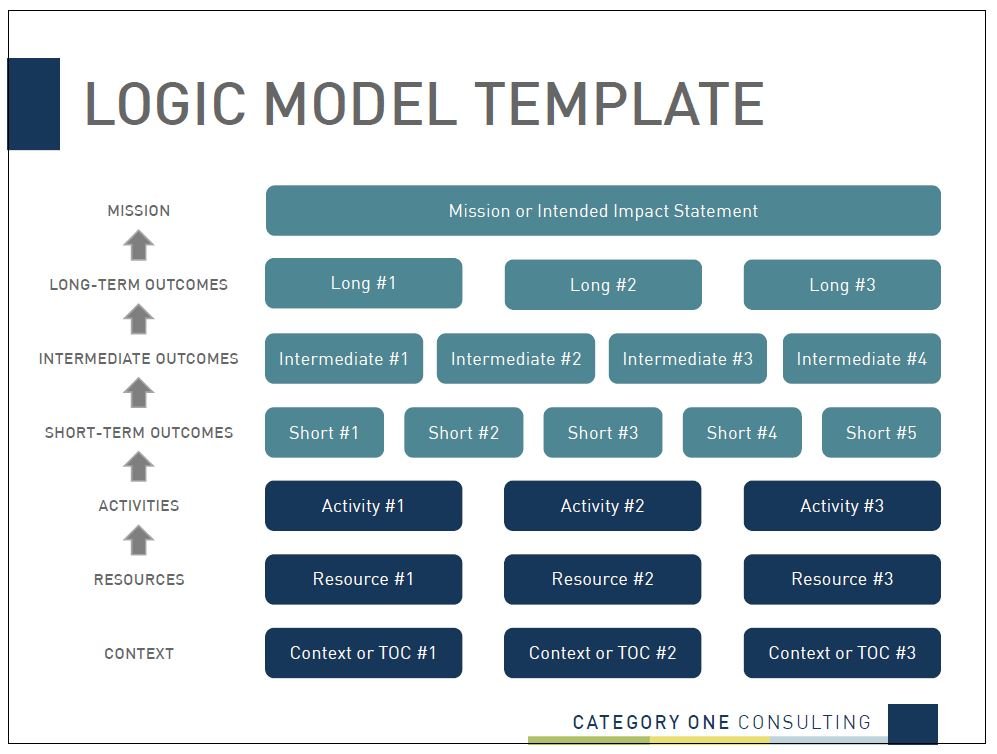Logic Models: A Template and Guide for Keeping It Simple
Individuals, both in corporate and nonprofit settings, who are tasked with developing, implementing, or evaluating initiatives (e.g., programs, projects, products) would benefit from using logic models. A logic model is a graphical display of what an initiative is, and what it aims to achieve. Logic models in their various formats are also often referred to as outcome hierarchies, outcome chains, and theories of change.
Although there is no right or wrong way to format the components of a logic model, many formats seem to overcomplicate the development process, as well as its subsequent use.
Although there is no right or wrong way to format the components of a logic model, many formats seem to overcomplicate the development process, as well as its subsequent use. For example, some logic model formats use the terms inputs, outputs, outcomes, and impacts to distinguish the components of the initiative (i.e., context, resources, activities) from the outcomes it is focused on achieving (i.e., outcomes, mission). The overlapping nature of these terms is often confusing to the person developing the logic model and the internal and external stakeholders that may need to review it.
To simplify the development of logic models and therefore facilitate effective and efficient planning, implementation, and evaluation of initiatives, Category One Consulting developed a simplified logic model template. The steps below provide a guide for how to utilize this template to create your own logic model.
Stay out of the weeds. Some logic model formats provide you with enough space to enter hundreds of items for each component. Unless this level of detail helps you to implement or evaluate your initiative, we recommend keeping this process a bit more high-level. What are the 3-5 key items that need to go under each component for successful planning, implementation, and evaluation of your initiative? Document those first…you can always go back and add more later if necessary.
Start with what you know. Rather than filling in your logic model from top to bottom or bottom to top, we recommend starting with what you know. Most often, you will know the resources (e.g., staff, budget, facilities) and activities (e.g., programs, meetings, trainings) affiliated with your initiative. You may also have a mission or intended impact statement documented as well as context or theory of change (TOC) statements identified. Fill those boxes in first, then move on to the boxes that you haven’t figured out yet. Most often, this will mean working outside in.
Work backwards on outcomes. We recommend working backwards on your outcome statements. Start with the mission or intended impact statement. Some questions you may ask yourself for this include: “Imagine that your initiative is 100% successful, what does that look like?” or “Fast forward 1, 3, or 5 years, what do you hope this initiative will have led to?”. Then work backwards from there starting with your long-term, then intermediate, then short-term outcomes. You can also write down all of the outcomes you hope to achieve on sticky notes, then place them in short-term, intermediate, and long-term categories. It may also help to define your timeframes for each of these (e.g., 6 months, 2 years) once you have identified the specific outcomes.
Keep measurement in mind, but don’t let it takeover. One of the main uses of a logic model is program evaluation. The logic model is used to specify initiative components and outcomes so that both of these (i.e., implementation and impact) can be measured and evaluated. As a result, it is important to think about how each of the items you include will be measured. Keep it in mind, but don’t let it dictate what you enter.
I hope this post helps you simplify logic model development in your role. If you need additional support with logic model development or program evaluation, feel free to reach out!


